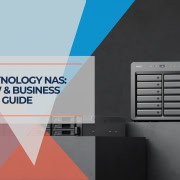Secure Your Business: 2024 Backup & Data Recovery Tactics
Last Updated on April 12, 2024
Data loss, whether caused by accidental deletion, hardware failure, or targeted cyberattacks, carries serious consequences for businesses. The cost of downtime and the potential damage to reputation can be devastating. As ransomware attacks grow in frequency and sophistication, traditional backup methods are proving increasingly vulnerable. This article examines why once-reliable data recovery strategies are insufficient and how the field is evolving to provide stronger protection.
Table of Contents
The Evolving Foundation of Data Recovery
The 3-2-1 rule has served as a valuable starting point for data protection. It promotes a basic level of redundancy and helps mitigate risks from localized disasters or single-device failures. However, the rise of advanced ransomware attacks has exposed vulnerabilities in traditional 3-2-1 implementations. Here's why:
Ransomware Targets Backups: Modern ransomware often seeks to encrypt your primary data and any backups it can find. Even connected network backups are at risk.
Limits of Geographic Separation: While important, off-site backups don't guarantee protection if ransomware can compromise your entire network infrastructure.
The Need for Immutability: To safeguard your data, at least one backup copy must be immutable – unchangeable even by malware or malicious actors.
Beyond 3-2-1: Building More Resilient Strategies
While the 3-2-1 rule remains relevant, successful data recovery in 2024 requires additional layers of protection. These include:
Offline or Air-gapped Backups: Isolated backups physically or logically disconnected from networks.
Cloud-Based Immutable Backups: Purpose-built cloud storage options that prevent modification or deletion of backups
Rigorous Backup Verification: Proactive testing of backups to ensure they are free of errors and usable in case of a recovery scenario.
In the upcoming sections, we'll explore these solutions in more detail, including the 3-2-1-1 and 3-2-1-1-0 rules and the role of technologies like Synology NAS in enhancing data recovery.
The Updated Standards: 3-2-1-1 and 3-2-1-1-0 Rules
To combat the increasing dangers of ransomware, IT experts have refined the classic backup strategy by adding extra layers focused on immutability and verification. Let's break down these updated rules:
The 3-2-1-1 Rule
The 3-2-1-1 rule builds upon its predecessor. The crucial addition is a fourth copy of your data stored in an immutable format. There are various ways to achieve this:
- Offline Backups: These are physically disconnected from the network (e.g., tapes stored offsite), making them inaccessible to malware by design.
- Air-Gapped Backups: These remain logically isolated on a separate network segment, with strict controls preventing unauthorized access.
- Cloud-Based Immutable Backups: Some cloud storage providers offer purpose-built immutable storage options, offering strong protection against modification or deletion.
With an immutable copy in place, you have a guaranteed recovery point even if a ransomware attack compromises all your other backups.
The 3-2-1-1-0 Rule
The 3-2-1-1-0 rule takes it even further, emphasizing the importance of thorough backup verification. Here's what the ‘0' stands for:
- Zero Errors: It's not enough to create backups; you must also proactively test them to ensure they contain no errors. A corrupted or improperly created backup is as useless as no backup. Regular validation is critical.
The 3-2-1-1-0 rule highlights a crucial truth: having backups is pointless if you can't trust their integrity. A false sense of security can be just as damaging as no security.
Synology NAS Snapshots for Enhanced Backup and Ransomware Protection
Synology NAS (Network Attached Storage) devices offer a built-in snapshot feature that can significantly boost your data recovery capabilities. Let's look at how it works and the benefits it provides:
- Snapshot Technology: Snapshots capture a shared folder's state at a specific time. These snapshots are stored on the NAS and are separate from your working data.
- Rapid Restoration: If ransomware deletes, corrupts, or encrypts a file, you can use snapshots to quickly roll back to a previous, unaffected version. This minimizes downtime and data loss.
- Ransomware Protection: Because snapshots aren't directly accessible by typical user accounts, they present a barrier to malware seeking to encrypt or delete your files.
Prerequisites
- Btrfs File System: Your Synology NAS must be formatted with the Btrfs file system to utilize snapshots.
- Snapshot Replication Package: This free package, available in the Synology Package Center, provides the snapshot management interface.
- Secure Credentials: Crucially, administer your NAS snapshots using a separate account from your standard user accounts. This helps ensure that even if ransomware compromises a user's login information, it can't manipulate the snapshots themselves.
Data Backup is Essential, But Disaster Recovery is Key
It's important to understand that simply backing up your data is only one piece of the puzzle. True disaster recovery (DR) encompasses the comprehensive plans and procedures needed to get your IT systems and your business back online after a major disruption. Let's clarify the difference:
- Backup: Focuses on creating copies of your data that can be restored.
- Disaster Recovery: encompasses the broader strategy of restoring not only data but also all of the critical systems and infrastructure (servers, network, applications, etc.) your business depends on to function.
RTO and RPO: Defining Your Recovery Needs
Two critical metrics form the cornerstone of your DR planning:
- Recovery Point Objective (RPO) defines the maximum acceptable amount of data loss you can tolerate. For example, an RPO of 24 hours means you should lose no more than a day's worth of data if a disaster strikes.
- Recovery Time Objective (RTO): This sets the target for how quickly you need your systems back up and running. An RTO of 4 hours means your DR plan must allow full restoration within that time.
Determining RTO and RPO
These aren't one-size-fits-all decisions. Factors to consider include:
- The nature of your data: How frequently does it change, and how essential is it?
- Regulatory requirements: Your industry may have specific compliance rules around data loss and recovery times.
- Cost vs. Benefit: Achieving extremely tight RPO and RTO targets often comes with higher technological and process complexity investments.
Note: DR plans extend beyond technology. They must outline who does what, where alternate workspaces exist, and how you'll communicate with customers and employees during an outage.

Data Backup and Recovery Market Trends in 2024
The data protection landscape is constantly evolving, driven by technological changes and the ever-present threat of ransomware. IT decision-makers must stay informed to ensure their investments align with the latest best practices. Here's where things are headed:
- Rise of BaaS (Backup as a Service): Cloud-based backup solutions are gaining widespread adoption due to their flexibility and scalability. BaaS offerings greatly simplify offsite replication and long-term data retention.
- AI and Machine Learning Advancements: AI/ML technologies play an increasing role in backup and recovery by:
- Smart Threat Detection: AI-powered tools can analyze data patterns to detect potential anomalies and ransomware activity early on.
- Optimized Recovery: AI can help prioritize the restoration of the most critical data and systems, minimizing downtime.
- Cloud Integration Deepens: Cloud storage is a key element of many modern backup strategies. Expect tighter integration with cloud platforms for seamless snapshot replication and long-term data archival.
- Flexible Licensing Models: Backup vendors are moving towards subscription models or consumption-based pricing, giving businesses greater cost control and adaptability.
- Containerized Backups: As applications move towards containerized environments, backup solutions are adapting to ensure consistent protection for these dynamic and distributed systems.
Conclusion
The ever-evolving threat of ransomware and the increasing consequences of data loss demand a rethinking of traditional backup approaches. Immutability and rigorous verification are now essential pillars of any robust data recovery strategy, alongside a detailed disaster recovery plan that addresses your business needs.
Staying ahead in data protection isn't merely about the latest technology. It's a mindset shift – recognizing that data is a precious asset needing proactive and continuous safeguarding. Your investments today to strengthen your data recovery practices can make the difference between a minor setback or a catastrophic failure during an incident.
This is a pivotal moment for businesses and tech enthusiasts alike:
- Assess: Critically evaluate your current data backup strategy. Are your backups immutable? Do you have a clear and tested disaster recovery plan?
- Learn: Stay updated on technology advancements and best practices. Seek advice from IT consultants if needed.
- Act: Proactively upgrade your data protection systems, policies, and training to reduce risk and improve resiliency.
Remember, an ounce of prevention is worth a pound of cure regarding your irreplaceable data.











Leave a Reply
Want to join the discussion?Feel free to contribute!